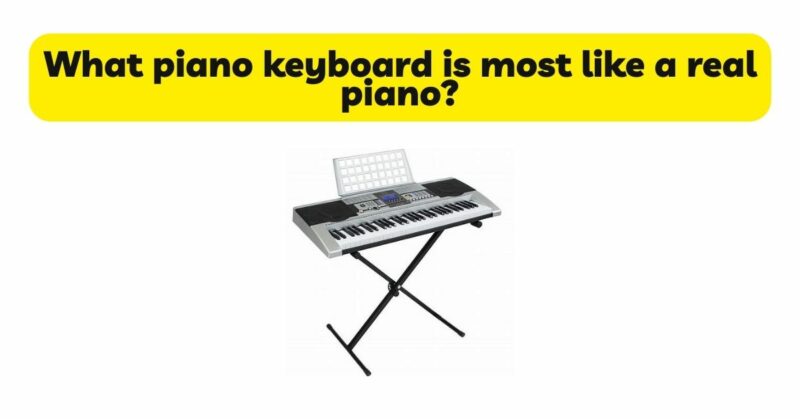For musicians seeking the authentic feel and sound of a real piano in a more compact and versatile instrument, piano keyboards that closely replicate the piano experience have become an attractive option. While nothing can fully replace the unique qualities of an acoustic piano, advancements in technology and engineering have allowed for the development of keyboard instruments that strive to emulate the touch, response, and tonal characteristics of their acoustic counterparts. In this article, we delve into the factors that contribute to a piano keyboard resembling a real piano, including key action, sound sampling, pedaling, resonance, and design. By examining these factors, we aim to provide insights into the piano keyboards that come closest to emulating the real piano experience, allowing musicians to make an informed choice that suits their musical preferences and needs.
- Hammer Action Keyboards: Piano keyboards with hammer action key mechanisms offer the most realistic touch and response, closely resembling the feel of playing on an acoustic piano. These keyboards incorporate weighted keys that replicate the weight and resistance of traditional piano keys. Graded hammer action keyboards go a step further by mimicking the graduated weight distribution of the keys, replicating the heavier touch in the lower register and lighter touch in the higher register. This feature allows musicians to experience a similar tactile response and dynamic control as when playing an acoustic piano.
- Sound Sampling: The quality and authenticity of the piano sound produced by a keyboard heavily depend on the sampling technology used. High-end piano keyboards employ advanced sampling techniques, capturing the nuances of each individual key on a real piano. This involves recording and reproducing the sound of each piano key at various dynamic levels, preserving the natural decay, resonance, and harmonic characteristics. Carefully sampled piano sounds create a more authentic and realistic playing experience, bringing the instrument closer to the tonal qualities of an acoustic piano.
- Pedaling: Realistic piano keyboards feature pedals that simulate the functionality of the sustain, soft, and sostenuto pedals found on acoustic pianos. These pedals allow musicians to achieve similar expressive control and tonal manipulation. High-quality piano keyboards often employ half-pedal functionality, which allows for subtle variations in pedal positioning, resulting in more nuanced and accurate pedaling techniques. The inclusion of these pedals enhances the authentic piano-playing experience and enables musicians to recreate the rich sustain and resonance of an acoustic piano.
- Resonance and Ambience Simulation: To emulate the resonant and immersive sound of an acoustic piano, some keyboards incorporate resonance and ambience simulation. These features replicate the sympathetic resonance of strings, mimicking the natural interaction and vibration between strings when specific keys are played. Additionally, virtual ambience simulation recreates the acoustic environment of a concert hall or studio, enhancing the overall sound experience. The inclusion of these features adds depth, richness, and realism to the piano sound, further blurring the line between the keyboard and a real piano.
- Design and Aesthetics: Piano keyboards that strive to mimic the experience of playing a real piano often incorporate design elements reminiscent of acoustic pianos. This includes the overall shape, the placement and appearance of the keys, and the presence of a music stand. The use of quality materials, such as wood and synthetic ivory or ebony for the keys, adds to the authentic feel and aesthetics of the instrument. These design choices create a visually pleasing instrument that visually resembles an acoustic piano, enhancing the overall playing experience.
- Hybrid Pianos: Hybrid pianos offer a unique combination of acoustic and digital elements, merging the traditional touch and sound of an acoustic piano with the versatility and digital features of a keyboard. These instruments feature a real acoustic piano action integrated with digital sound generation and customization options. The acoustic components provide the authentic touch and response of a real piano, while the digital aspects offer a wide range of sounds, recording capabilities, and connectivity options. Hybrid pianos provide an excellent compromise for musicians seeking both the traditional piano experience and the advantages of digital technology.
Conclusion: While piano keyboards can come remarkably close to emulating the touch, sound, and overall experience of playing a real piano, it is important to note that they are not identical substitutes. Factors such as key action, sound sampling, pedaling, resonance, and design contribute to the authenticity and realism of piano keyboards. Models that incorporate hammer action keys, high-quality sound sampling techniques, realistic pedal functionality, resonance simulation, and design elements reminiscent of acoustic pianos come closest to replicating the real piano experience. However, each musician’s preferences, requirements, and budget will ultimately determine the most suitable instrument. Piano keyboards offer the advantages of portability, versatility, and digital capabilities while providing a convincing approximation of the real piano experience. Musicians should consider their playing style, musical goals, and personal preferences when selecting a piano keyboard that best captures the essence of playing a real piano, allowing them to express their creativity and enjoy the pleasure of music-making.


